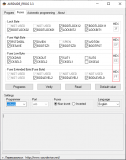The first stealth modchip supporting unlocking BIOS of Japanese versions Sony PlayStation 1
This project was developed by brill & postal2201 (me
http://www.emu-land.net/forum/index.php ... 934.0.html
Main features of PSNee V8:
1. Support for BIOS patching of Japanese consoles. Now you don't need to change the BIOS chip to hack Japanese consoles.
2. New type of BIOS patching for SCPH-102. Now the console BIOS does not switch to 60Hz on boot, so there should be no problem with portable LCD screens.
3. Auto region mod. The chip sends the SCEX code corresponding to your console model, unlocking is faster.
4. Ability to disable BIOS patching using a switch, without flashing the chip.
5. Refusal of all Arduino functions. The Arduino.h library is not used in the project.
PsNee V8 supports the following MCU's:
- ATmega328(A/P/PA) @16Mhz
- ATmega168(A/P/PA) @16Mhz
To install via the Arduino IDE may require the installation of the MiniCore package.
https://github.com/MCUdude/MiniCore
Use the programmer to flash MCU. Flashing via COM port is not supported.
Don't use a bootloader!
Example of correct setting for ATmega328P:
Before flashing the MCU, you need to configure the fuses.
- Fuses for JAP_FAT consoles: H: DF, L: EE, E: FF
- Fuses for all other consoles: H: DF, L: FF, E: FF
The division by model for JAP_FAT consoles, especially 5000 and earlier models, is rather arbitrary. When choosing a configuration in the .ino file, it is advisable to focus on the CRC BIOS of your console. To check the CRC, you can use the Bios Dumper attached in the attachment.
Installation diagram:
https://github.com/postal2201/PSNee_V8





 , "PlayStation",
, "PlayStation",  ,
,  , "DUALSHOCK", "Net Yaroze" and "PSone" are registered trademarks of Sony Computer Entertainment Inc.
, "DUALSHOCK", "Net Yaroze" and "PSone" are registered trademarks of Sony Computer Entertainment Inc.  .
.